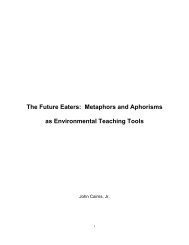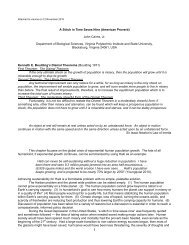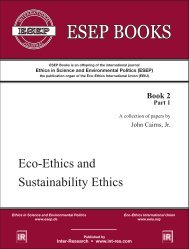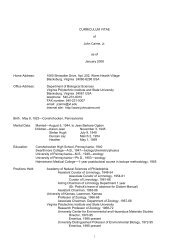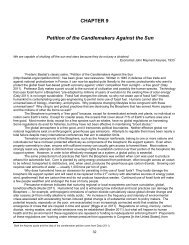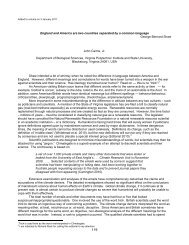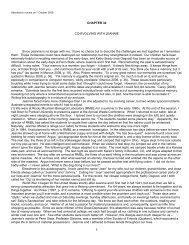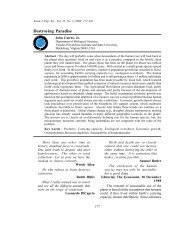View - ResearchGate
View - ResearchGate
View - ResearchGate
You also want an ePaper? Increase the reach of your titles
YUMPU automatically turns print PDFs into web optimized ePapers that Google loves.
208Cairns: Eco-Ethics and Sustainability EthicsTechnological solutions may not appear in time (AIDS is a contemporary example). This scenario isespecially true if severe consequences appear suddenly (e.g., major climate changes) and limitresources that might be available for research. I find this faith in a technological solution to allenvironmental problems particularly disingenuous in an era when research funds have diminisheddramatically. A quality research establishment is slow to develop, but quickly disassembled. In contrast,recognition of collateral problems associated with new technologies may appear suddenly andhave potentially devastating consequences. A contemporary example is hormone disruptors (e.g.,Colborn and Clement, 1992; Colborn et al., 1996).CHAOS, TERRORISM, AND SUSTAINABILITYOne of the ironies of the present is that a substantive level of global social stability is essential if thetransition to sustainability is to be without major human suffering. Sustainable development duringperiods of widespread, armed conflict seems unlikely. Funding the transition period will require eithernew taxes or diversion of present tax funds. If the United Nations could diminish aggression, some ofthe funds could be reallocated from the military budget. At present, this seems highly unlikely. Evenif aggressor states disappeared, attempts to control terrorists could still easily divert too much of thefinite societal resources from the quest for sustainability. Last, but not least, Durant and Durant (1968)note: “leave men free, and their natural inequalities will multiply almost geometrically” (p. 20). Theinequalities can be diminished by sacrificing liberty, as in Russia after 1917, or by redistribution ofwealth through graded taxation, as many European and North American countries have done. Chaosin any form (earthquakes, economic upheavals, war, or epidemic diseases) is a threat to sustainability,but need not destroy it.ETHOS, EQUITY, AND FAIRNESSTechnology has no value system, although it creates problems and sometimes provides solutionsto the problems it created. Mercantile systems may focus too intently on a primary value (profit),although there is persuasive evidence that having other values (e.g., concern for employees) benefitsthe corporation as well. However, the quest for sustainability is based on a rather complex valuesystem that covers large temporal and spatial spans. Robust value systems emerge as a result ofextensive public discussion and debate (e.g., United States child labor laws). The tools to induce anappropriate social behavior for sustainability are few: (1) regulate, (2) litigate, and (3) enforce appropriateregulations that come from pressure exerted by citizen action groups. This achievement requiresethos (a set of guiding beliefs), equity, and fairness. However, if human society is not capable of achievingthese, there will be consequences if, as I believe, humans are still subject to the biophysical lawsof nature.LITERATURE CITEDAbernethy, V.D. (1997). The right incentive: how perceived scarcity may stop population growth in time. Politicsand the Life Sciences, 16(2), 193–195Cairns, J., Jr. (1994). Ecological restoration: re-examining human society’s relationship with natural systems.The Abel Wolman Distinguished Lecture. Washington, D.C.: Water Science and Technology Board,National Research CouncilCairns, J., Jr. (1995). Eco-societal restoration: re-examining human society’s relationship with natural systems.Annals of Earth, 13(1), 18–21Cairns, J., Jr. (1996). Determining the balance between technological and ecosystem services in EngineeringWithin Ecological Constraints, pp. 13–30. P.C. Schulze, (Ed.), Washington, D.C.: National AcademyPress



